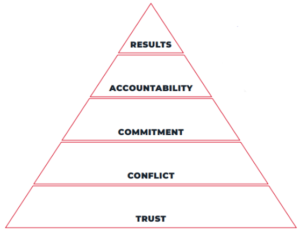CEOs and business leaders are always focused on growth and outpacing the competition. Patrick Lencioni sums up how to get and keep The Advantage in this 2012 book. And though the book was published 10 years ago, now may be the ideal time to apply these concepts to your business.
Unlike his other business parables, The Advantage uses no story to share the concepts. They’re pretty simple – an organization’s success is determined by the strength and cohesion of the leaders, and the clarity they create, communicate and reinforce with the team. Lencioni says that the companies try to be smart – focusing on strategy, finance and technology, but first they need to be healthy – with a strong culture, clarity, engagement, high productivity and low turnover. Here’s how:
#1. Create a Cohesive Leadership Team
– The leadership team is small (3 to 8 people)
– Members of the team trust one another and can be genuinely vulnerable with each other
– Team members regularly engage in productive, unfiltered conflict around important issues
– The team leaves meetings with clear-cut, active and specific agreements around decisions
– Team members hold one another accountable to commitments and behaviors
– Members of the leadership team are focused on team number one. They put the collective priorities and needs of the larger organization ahead of their own departments.
#2. Create Clarity
– Members of the leadership team know, agree on, and are passionate about the answers to a few key questions:
Why do we exist? (fundamental purpose/mission)
How do we behave? (small set of core behavioral values)
How do we succeed? (strategy that defines success/differentiates from competitors)
What’s most important right now? (a single current goal with collective ownership)
Who does what? (defined roles and responsibilities with open, consistent dialogue about one another’s work)
#3. Overcommunicate Clarity
– The leadership team has clearly communicated the answers to all employees.
– Team members regularly remind the people about those aspects of clarity.
– The team leaves meetings with clear and specific agreement about what to communicate to their employees, and they cascade those messages quickly after meetings.
– Employees are able to accurately articulate the organization’s reason for existence, values, strategic anchors and goals.
#4. Reinforce Clarity
– The organization ensures new hires are carefully selected based on the company’s values.
– New people are thoroughly taught the elements of clarity.
– Managers throughout the organization have a simple, consistent and non-bureaucratic system for setting goals and reviewing progress with employees.
– Employees who don’t fit the values are managed out of the company. Poor performers who do fit the values are given the coaching and assistance they need to succeed.
– Compensation and reward systems are built around the values and goals of the organization.